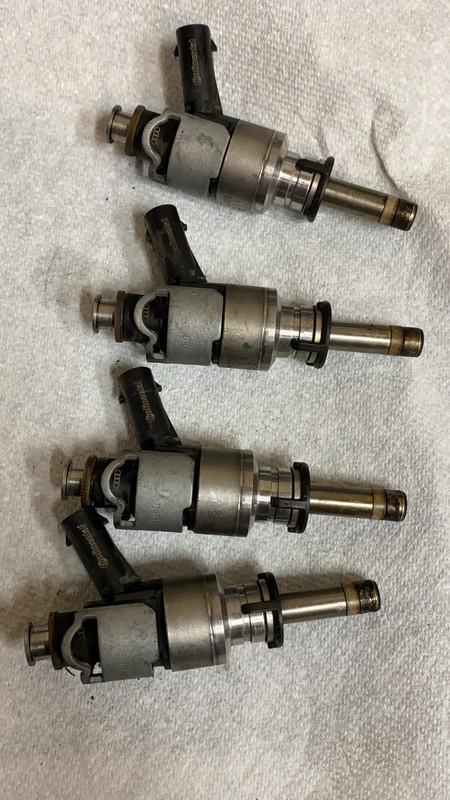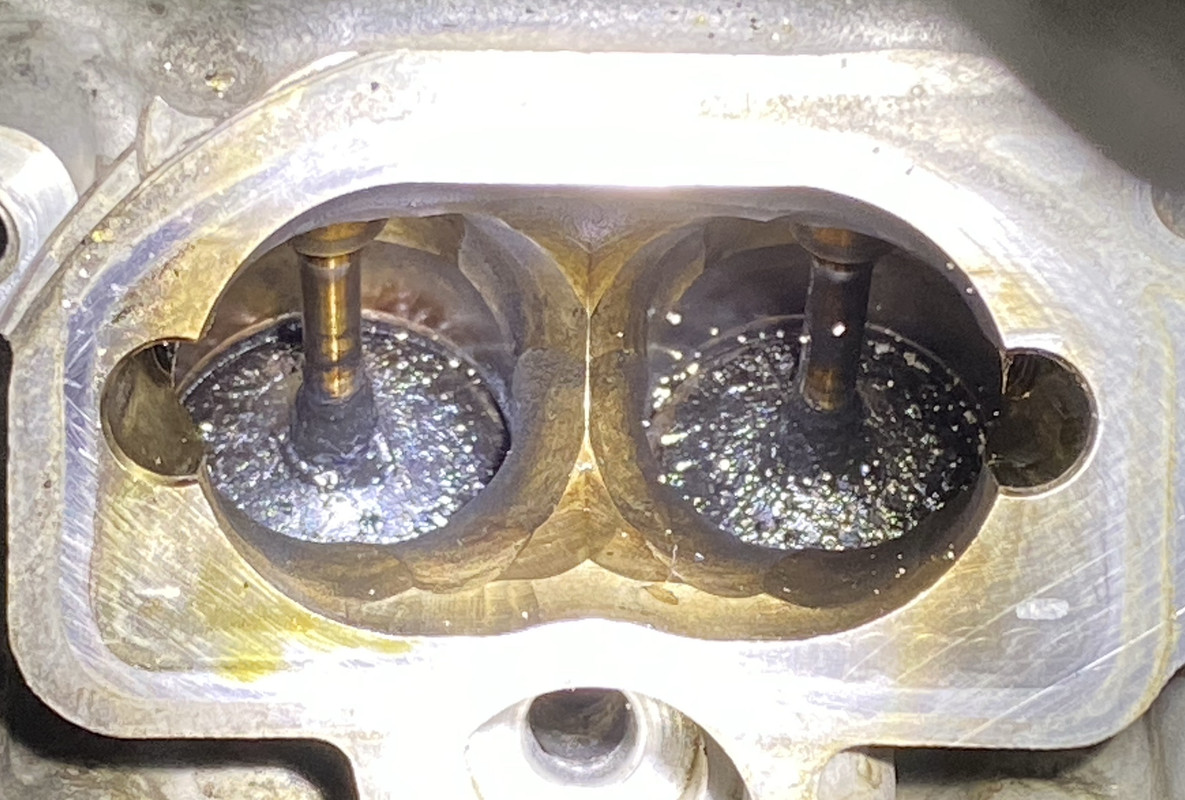Not sure carbon cleaner via the throttle bodies would be ideal from a distribution standpoint.
Random thoughts...I've thought about just spraying the valves directly (periodically) with cleaner and letting it sit overnight kind of thing. May consider doing that the night before an oil change (potential dilution issues as the solvent seeps past the rings). I can pull the manifold pretty easily now, takes me less than an hour. The main issue would be removing the lower intake manifold and pulling the injectors out of their bores. They came up with the lower intake manifold again. All of them, both sides. But...one could use a vacuum pump and just pump the flaps open and shoot the valves that way. Most of the heavy buildup is on the back of the valve head. As you can see in the photo, the stems were fairly clean as were the walls (very thin, transparent layer). One or two were worse than the others but most were about the same as the photo. I pulled the MAP sensor but it was fairly clean. The intake runners had a very thin layer of oil on them but they weren't dripping with oil by any means. I did clean the port dividers as I could just pull them easily and wash them off.
Since installing the new injectors, I've noticed a few things. First, the engine sounds a bit meaner. More pops and bangs on easy shifts and deceleration. Idle is super smooth and the engine is a bit more crisp overall and seems to have gained some volume with the exhaust flaps open. I reset the fuel trim and I noticed, right away, the short term idle fuel trim went into negative territory. I'm sure the car is going to adapt over time to the new injectors. There's less hesitation than before too. I'll continue to monitor changes in short and long term fuel trim. Bank 1 was generally at about +6% which is very close to the maximum deviation from normal before needing to change components out. I'll need to drive my normal loop to really determine any changes. Haven't had the chance to do that yet.
I've been looking for a service to have the original injectors inspected, cleaned and rebuilt if possible. From what I've been reading, there are two ways they fail; dirt clogging up the internal passages and the piezo crystals cracking. There's nothing that can be done about the crystals physically cracking.
In terms of testing, I haven't found anyone who states they're being tested at full pressure which might be an issue for spray pattern and ultimately flow. One company said they just interpolate via mathematics but I don't think that'll be 100% accurate. There are large differences between testing at 100psi and 3,000psi.
I did notice the #3 cylinder looked REALLY clean. Valves were open enough I could see the piston. Most of the misfires were coming at idle and would stop if I increased the revs. I monitored that in real time.
About three days before throwing codes, the exhaust sound changed ever so slightly. It was very slight but I noticed and didn't think too much of it other than it was odd. A day before the codes were thrown, I felt like the car was slightly down on power. Still idled fine. The day codes were stored and the engine light came on, I had a definite "lope" like one cylinder wasn't firing (and it wasn't as the cylinder was disabled). You can clear the codes and the car will run with the periodic miss but you'll risk total injector failure and possible hydrolock. Given my misfires were at idle, I wasn't super worried but I was also headed out of town and wouldn't be driving the car.
Pulling the plugs, the porcelain insulator on #3 was darker than the other cylinders. The ground strap/electrode was clean.
I think these injectors "work" until they don't. Perhaps spray pattern gets bad but they generally work well enough that the car seems to perform until there's a full injector failure. They reach a certain point where either idle is affected (and it's obvious) or a code is thrown. There wasn't a particular issue that led me to believe the injector was on it's way out. I think if you keep track of misfires via the VCDS, you may catch it early. The misfire count on 3 was pretty high. The only early sign, as I mentioned earlier, was the slightly changed exhaust tone. It wasn't the pulsing that changed, it was the actual tone or timbre of the exhaust. It developed a slight "cocked" sound, a bit higher in pitch. The musicians here will know what I mean.
Perhaps, just maybe, this was one of the reasons why I haven't been achieving better elapsed times when I hit the drag strip. My mph is way up but not my ET. I'll try to head back to the drag strip soon to see if there's any improvement. Any hesitations seem to have been greatly reduced, maybe that'll translate into a better ET.
From a maintenance standpoint, this may be something we all consider doing at some point if performance is the main driver. There are many RS5's who've never experienced an injector failure, even those with over 100K miles. Like every other part, it's a crap shoot. With that said, I had one obviously bad injector and one other which had a higher misfire count than the rest. But six were just fine as far as I can tell. Perhaps testing will reveal injector issues which could lead to reduced performance.
I know the injector has had several part number revisions. Maybe it's just that, a number, or maybe Continental made internal changes. Who knows. But here's the full list of former part numbers;
Supersession(s): 079906036AC; 079906036G; 079906036N; 079906036T; 79906036AD
We really just need to develop an auxiliary port injection rail. If our Bosch Medtronic 17.1.1 is capable of controlling 16 injectors, it wouldn't be super hard to design a new lower intake manifold using the R8 V2 Gen 2 LIM as a template. Same intake port spacing. Flaps would be eliminated and there's enough room outboard to add injector bungs and a rail. Wouldn't be cheap but it'd most likely cost the same as two carbon cleanings. Thinking this may be my next project. The R8 V10 uses the same ECU, 17.1.1, which has to control 20 injectors, 10 piezo GDI and 10 port. Food for thought.













 Reply With Quote
Reply With Quote










Bookmarks